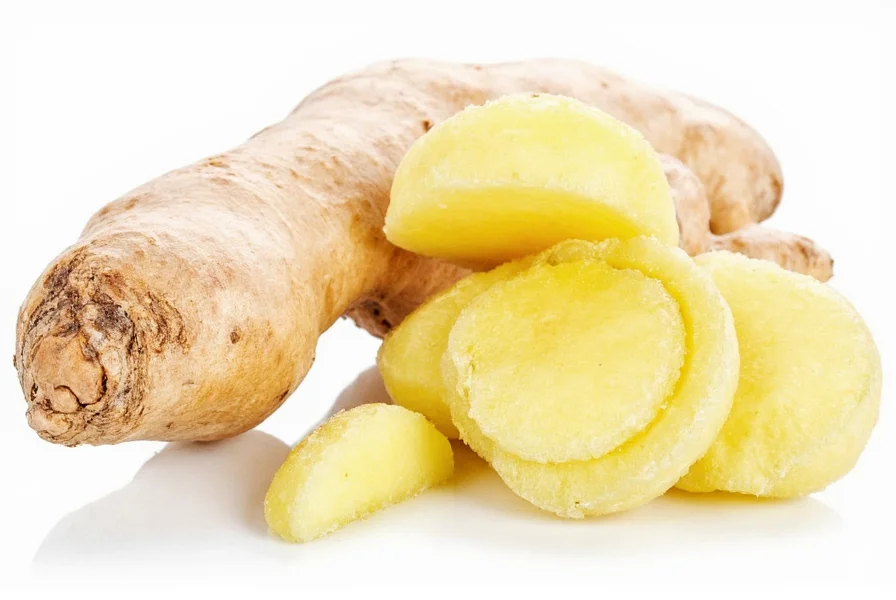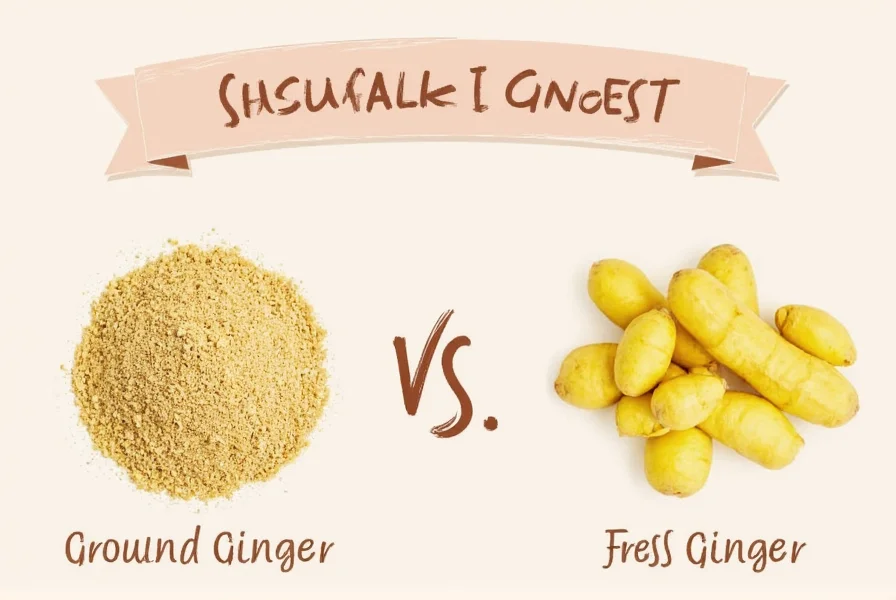When your recipe calls for fresh ginger but you only have ground ginger in your spice cabinet, understanding the proper substitution ratio is essential for maintaining your dish's intended flavor profile. While not a perfect 1:1 replacement due to differences in moisture content and volatile compounds, ground ginger can effectively stand in for fresh when used correctly.
Understanding Ginger's Flavor Transformation
Ground ginger undergoes significant chemical changes during the drying and grinding process that affect its flavor profile compared to fresh ginger. Fresh ginger contains gingerol, which provides that characteristic spicy, bright kick. When dried and ground, gingerol converts to zingerone and shogaol—compounds that deliver a warmer, earthier, and slightly sweeter flavor with less of the fresh rhizome's citrusy notes.
This transformation explains why ground ginger works better in certain applications than others. The drying process concentrates the spice while eliminating fresh ginger's fibrous texture and higher water content, making ground ginger ideal for dry rubs, baked goods, and long-cooked dishes where moisture isn't critical.
The Standard Substitution Ratio Explained
The widely accepted conversion is 1/4 teaspoon of ground ginger equals 1 tablespoon of freshly grated ginger. This 1:3 ratio accounts for ground ginger's intensified flavor concentration after moisture removal. However, this isn't merely a mathematical conversion—it's based on sensory testing that considers how each form interacts with other ingredients.
| Recipe Requirement | Ground Ginger Substitute | Best Application |
|---|---|---|
| 1 tablespoon fresh ginger | 1/4 teaspoon ground ginger | Baking, spice blends |
| 2 tablespoons fresh ginger | 1/2 teaspoon ground ginger | Curries, stews |
| 1/4 cup fresh ginger | 1 teaspoon ground ginger | Dry rubs, marinades |
| 1/2 cup fresh ginger | 2 teaspoons ground ginger | Long-simmered sauces |
When substituting in recipes requiring larger quantities of ginger, consider reducing the substitution ratio slightly. For example, if a recipe calls for 1/2 cup of fresh ginger, try using 1 3/4 teaspoons of ground ginger instead of the full 2 teaspoons, then adjust to taste. This prevents the earthier notes of ground ginger from overwhelming other flavors.

When Ground Ginger Works Best as a Substitute
Certain cooking applications handle the ground ginger substitution more gracefully than others. Understanding these contexts helps you decide when to reach for your spice cabinet versus making a grocery run for fresh ginger.
Baking applications represent the most successful substitution scenario. In gingerbread, cookies, and spice cakes, ground ginger's concentrated flavor actually enhances the final product. The baking process allows ground ginger's warmer notes to meld beautifully with other spices like cinnamon and cloves, often producing superior results to fresh ginger in these applications.
Long-cooked dishes such as curries, stews, and braises also accommodate ground ginger well. During extended cooking times, ground ginger has opportunity to rehydrate and distribute its flavor evenly throughout the dish. Add ground ginger early in the cooking process to allow its flavors to develop fully—unlike fresh ginger, which often benefits from later addition to preserve its brighter notes.
Liquid-based recipes like chai, ginger tea, or syrups work reasonably well with ground ginger substitution. The liquid medium helps disperse the powder evenly, though you may want to strain the final product if texture concerns you. For these applications, consider blooming the ground ginger in a small amount of warm liquid before adding to your main mixture to prevent clumping.
When to Avoid Substituting Ground for Fresh Ginger
While ground ginger serves as a practical substitute in many situations, certain culinary applications demand fresh ginger's unique qualities that ground simply cannot replicate.
Raw applications like sushi ginger, fresh salsas, or uncooked dressings lose the vibrant, spicy-citrus notes that make fresh ginger special. Ground ginger lacks the bright top notes and delivers a one-dimensional flavor that can taste dusty or stale in raw preparations. If you must substitute, add a squeeze of citrus to help brighten the flavor profile.
Texture-dependent dishes suffer when substituting ground ginger. In stir-fries where thin slices of fresh ginger provide pleasant textural contrast, ground ginger creates an unpleasant powdery mouthfeel. Similarly, in dishes like ginger scallion sauce where visible ginger threads are part of the aesthetic, ground ginger won't deliver the expected visual or textural experience.
Authentic Asian cuisine often relies on fresh ginger's specific flavor compounds that transform during cooking. In many Thai, Vietnamese, and Chinese dishes, fresh ginger provides a crucial flavor dimension that ground ginger cannot match. For authentic results in these cuisines, fresh ginger remains preferable when possible.

Professional Tips for Optimal Substitution Results
Seasoned cooks employ several techniques to maximize the effectiveness of ground ginger when substituting for fresh. These professional approaches help bridge the flavor gap between the two forms:
Timing matters—add ground ginger earlier in the cooking process than you would fresh ginger. While fresh ginger often benefits from later addition to preserve its volatile compounds, ground ginger needs time to hydrate and release its flavors fully. For sautéed dishes, add ground ginger to the oil first, allowing it to toast slightly before adding other ingredients.
Boost with complementary flavors when substituting in recipes where fresh ginger's bright notes are crucial. A small squeeze of lemon or lime juice can help approximate fresh ginger's citrus undertones. For savory dishes, consider adding a pinch of cayenne to mimic fresh ginger's sharper heat profile.
Store properly to maintain ground ginger's potency. Unlike fresh ginger, which lasts weeks refrigerated, ground ginger loses potency quickly once opened. Keep it in an airtight container away from light and heat, and replace every 6-12 months for best results. Older ground ginger will require slightly larger quantities to achieve the same flavor impact.
Consider partial substitution in important recipes. If you have some fresh ginger but not enough for the full recipe, combine what you have with ground ginger rather than substituting entirely. This hybrid approach preserves some fresh flavor while extending your supply.
Frequently Asked Questions
Can I use ground ginger instead of fresh in curry?
Yes, but with adjustments. Use 1/4 teaspoon ground ginger per tablespoon of fresh ginger called for, and add it early in the cooking process. For authentic Thai or Indian curries, fresh ginger provides superior flavor complexity, but ground works acceptably in Western-style or tomato-based curries where other strong flavors dominate.
Why does my substitution taste different even with the correct ratio?
Ground ginger has a warmer, earthier flavor profile than fresh due to chemical changes during drying. Fresh ginger contains more volatile compounds that provide bright, citrusy notes lost in the drying process. Your substitution tastes different because it's chemically distinct, not because of measurement error.
How do I adjust recipes calling for ginger paste when using ground ginger?
Treat ginger paste similarly to fresh ginger but use slightly less ground ginger. For 1 tablespoon ginger paste, substitute 3/16 teaspoon ground ginger. Ginger paste is more concentrated than freshly grated ginger but less than ground powder, so it falls between the two forms in intensity.
Does the substitution ratio change for different types of recipes?
Yes, the ideal ratio varies by application. In baking, you can often use the full 1:3 ratio. For savory dishes, especially Asian cuisine, reduce to 1:4 (1/4 teaspoon ground to 1 tablespoon fresh). In raw applications, the substitution works poorly regardless of ratio due to fundamental flavor differences.
Can I make my own ground ginger from fresh?
Yes, but it requires proper technique. Peel and thinly slice fresh ginger, then dehydrate until completely brittle (about 8-12 hours at 135°F/57°C). Grind to a fine powder in a spice grinder, then sift. Store in an airtight container. Homemade ground ginger will be more potent than commercial varieties but still lacks fresh ginger's volatile compounds.











 浙公网安备
33010002000092号
浙公网安备
33010002000092号 浙B2-20120091-4
浙B2-20120091-4